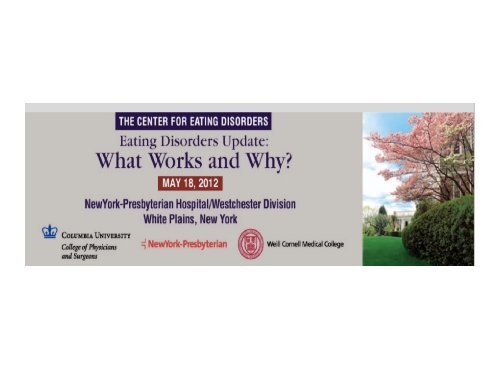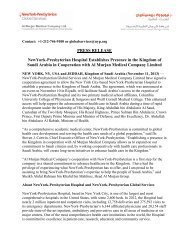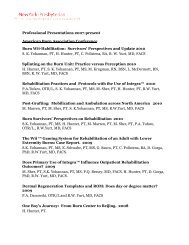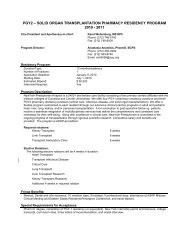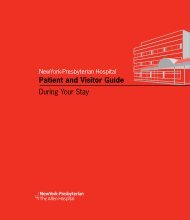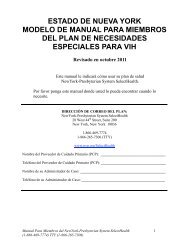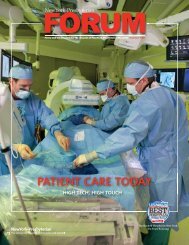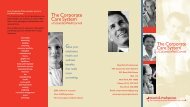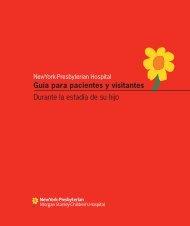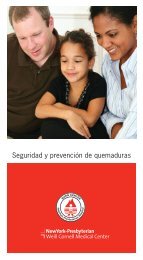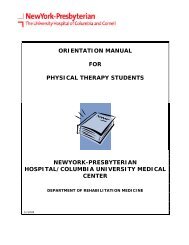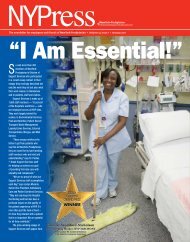The Center for Eating Disorders - NewYork-Presbyterian. The ...
The Center for Eating Disorders - NewYork-Presbyterian. The ...
The Center for Eating Disorders - NewYork-Presbyterian. The ...
You also want an ePaper? Increase the reach of your titles
YUMPU automatically turns print PDFs into web optimized ePapers that Google loves.
<strong>The</strong> <strong>Center</strong> <strong>for</strong> <strong>Eating</strong> <strong>Disorders</strong><br />
Ea#ng <strong>Disorders</strong> <br />
Research Unit <br />
NYSPI <br />
at Westchester<br />
Columbia<br />
Day Program<br />
@East 60th
Today’s Agenda <br />
9:00-‐9:30 A new model <strong>for</strong> anorexia nervosa <br />
B. Timothy Walsh, MD <br />
9:30-‐10:00 <br />
10:00-‐10:30 <br />
10:30-‐10:45 <br />
10:45-‐11:15 <br />
11:15-‐12:45 <br />
<strong>The</strong> role of medicaDon in eaDng disorders treatment <br />
Evelyn AFa, MD <br />
What predicts weight loss success? <br />
Laurel Mayer, MD <br />
Coffee Break! <br />
NutriDonal and eaDng disorders <br />
Janet Schebendach, PhD <br />
Evidence-‐based treatments: A case-‐based discusssion <br />
A GoXlieb, P Raizman, J Steinglass, J Schebendach,
• Rita Golden <br />
• Mary Beth Kea7ng <br />
• Kathleen Propp <br />
• Mike Smith <br />
• Barbara Smolek <br />
Thank You!
<strong>The</strong> role <strong>for</strong> medicaDon in <br />
eaDng disorders treatment <br />
Evelyn AFa, MD <br />
May 18, 2012
NYS Psychiatric Unit <br />
Nichole Barbarich-‐Marsteller <br />
Allegra Bro? <br />
Michael Devlin <br />
Deborah Glasofer <br />
Juli Goldfein <br />
Diane Klein <br />
Rachel Marsh <br />
Laurel Mayer <br />
Pamela Raizman <br />
Janet Schebendach <br />
Robyn Sysko <br />
B Timothy Walsh <br />
New York-‐<strong>Presbyterian</strong>/<br />
Westchester <br />
Zoe Bisbing <br />
Alessia GoOlieb <br />
Melissa Klein <br />
Dennis McNabb <br />
BeOy Morin <br />
Parinda Parikh <br />
Laura Price <br />
Diahann Smith-‐Roberts <br />
Columbia Eastside <br />
Chiara BaQstello <br />
Michelle Brill <br />
Heather Paley
Disclosure <br />
I receive support from Eli Lilly & Co
EaDng <strong>Disorders</strong> <br />
Anorexia Nervosa <br />
Bulimia Nervosa <br />
Binge EaDng Disorder
Bulimia Nervosa <br />
Key DiagnosDc Features <br />
• Recurrent episodes of binge eaDng <br />
• Recurrent inappropriate behaviors to avoid <br />
weight gain (e.g., vomiDng, laxaDve misuse) <br />
• Episodes occur > 2x/week <strong>for</strong> >3 months
Bulimia nervosa <br />
• Age of onset: late adolescence, young <br />
adulthood <br />
• Age of presentaDon > onset <br />
• Prevalence: 1-‐3 % <br />
• Females > males <br />
• Normal weight <br />
• Serious medical complicaDons uncommon <br />
• High rates of co-‐morbid depression
Bulimia Nervosa <br />
Dental Erosion
Bulimia Nervosa
Bulimia Nervosa <br />
• AnDdepressants: <br />
– High rates of co-‐morbid depression, <br />
anxiety <br />
– Evidence <strong>for</strong> noradrenergic, serotonergic <br />
disturbance <br />
• Mood stabilizers/anD-‐seizure <br />
• Opioid antagonists <br />
• Other novel agents
Controlled Trials of AnDdepressants <br />
in Bulimia Nervosa <br />
Author MedicaDon n Length <br />
Sabine et al Mianserin 36 8 <br />
Pope et al Imipramine 19 8 <br />
Mitchell & Groat Amitriptyline 32 8 <br />
Hughes et al Desipramine 22 6 <br />
Walsh et al Phenelzine 50 6 <br />
Agras et al Imipramine 22 16 <br />
Kennedy et al Isocarboxazid 18 6 <br />
Barlow et al Desipramine 24 6 <br />
Blouin et al Desipramine 10 6 <br />
Horne et al Bupropion 49 8 <br />
Pope et al Trazodone 42 6 <br />
Mitchell et al Imipramine 74 10 <br />
Enas et al FluoxeDne 382 8 <br />
Walsh et al Desipramine 78 6 <br />
Wheadon et al FluoxeDne 390 16 <br />
Kennedy et al Brofaromine 36 8 <br />
Alger et al Imipramine 22 8 <br />
Freeman et al Fluvoxamine 8
AnDdepressant Treatment <br />
of Bulimia Nervosa <br />
med<br />
placebo<br />
60 mg/d<br />
20 mg/d
Bulimia Nervosa: <br />
Time Course of Response to FluoxeDne <br />
Fluoxetine, at 60 mg/d, was initiated on Day 1. <br />
Dose was well-tolerated!
120 women<br />
CBT = Med<br />
CBT > SPT<br />
Tx/Meds > Tx/Pbo<br />
Walsh, Am J Psychiatry, 1997
FluoxeDne following unsaDsfactory response to <br />
psychotherapy <strong>for</strong> Bulimia Nervosa <br />
Walsh et al, 2001
Other medicaDons in BN <br />
• Mood stabilizers <br />
– Topiramate <br />
• AnD-‐emeDc <br />
– Odansetron <br />
• Other agents <br />
– Naltrexone <br />
– Baclofen
MedicaDon Treatment <strong>for</strong> BN <br />
• AnDdepressants useful <strong>for</strong> decreasing ED <br />
behaviors and improving mood <br />
• FluoxeDne HCl is the only medicaDon with <br />
specific FDA indicaDon <strong>for</strong> the treatment of BN <br />
• Higher doses may be needed than that generally <br />
prescribed <strong>for</strong> depression <br />
• When they work, they work fast <br />
• <strong>The</strong>y are worth trying even in individuals who fail <br />
to respond to psychotherapy
Binge EaDng Disorder: <br />
Key DiagnosDc Features <br />
• Recurrent binge eaDng (objecDvely large <br />
amount of food and loss of control) <br />
(same as bulimia) <br />
• No compensatory behavior <br />
(clearly different from bulimia) <br />
• Marked distress about the behavior
Binge EaDng Disorder <br />
Clinical Features <br />
Compared with paDents with anorexia nervosa <br />
and bulimia nervosa, those with Binge EaDng <br />
<strong>Disorders</strong>: <br />
are older (~middle aged) <br />
more frequently male (40-‐50%) <br />
Most are overweight or obese. <br />
Low levels of mood and anxiety disturbance are <br />
common.
Goals of Treatment <strong>for</strong> Obese PaDents <br />
With BED <br />
• NormalizaDon of eaDng paXerns and cessaDon <br />
of binge eaDng (BEHAVIORAL) <br />
• Management of obesity (SOMATIC) <br />
• ReducDon of overall distress: remediaDon of <br />
depressive symptoms and enhanced self-acceptance<br />
(PSYCHOLOGIC)
MedicaDons Examined <br />
<strong>for</strong> Treatment of BED <br />
• AnDdepressants <br />
– TCAs: desipramine, imipramine <br />
– SRIs: fluvoxamine, sertraline, fluoxeDne, citalopram <br />
• FDA approved anDobesity agents <br />
– sibutramine <br />
– orlistat <br />
• Other <br />
– Naltrexone <br />
– Topiramate <br />
– Zonisamide <br />
– AtomoxeDne <br />
– Baclofen
Controlled MedicaDon Trials in BED <br />
Author Medication(s) N<br />
Length<br />
(weeks)<br />
McCann (1990) Desipramine 23 12<br />
Alger (1991)<br />
Imipramine<br />
Naltrexone<br />
55 8<br />
Stunkard (1996) d-Fenfluramine* 28 8<br />
Hudson (1998) Fluvoxamine 85 9<br />
McElroy (2000) Sertraline 34 6<br />
Arnold (2002) Fluoxetine 60 6<br />
McElroy (2003) Citalopram 38 6<br />
McElroy (2003) Topiramate 58 14<br />
Appolinario(2003)<br />
Grilo (2005)<br />
Golay (2005)<br />
McElroy (2006)<br />
McElroy (2007)<br />
Wilfley (2008)<br />
Sibutramine<br />
Orlistat + CBT<br />
Orlistat<br />
Zonisamide<br />
Topiramate<br />
Sibutramine<br />
60<br />
50<br />
89<br />
60<br />
394<br />
304<br />
12<br />
12<br />
24<br />
16<br />
16<br />
24
Efficacy of Meds <strong>for</strong> Treatment of BED <br />
% Reduction in Binge Frequency<br />
placebo<br />
ac%ve <br />
medica%on <br />
McCann (1990)<br />
Desipramine <br />
Naltrexone <br />
Imipramine <br />
d-‐Fenfluramine <br />
Fluvoxamine <br />
FluoxeDne <br />
Citalopram <br />
Sibutramine <br />
Sertraline <br />
Topiramate <br />
Orlistat + CBT <br />
Orlistat <br />
Zonisamide <br />
AtomoxeDne <br />
Topiramate<br />
Sibutramine
Efficacy of Meds <strong>for</strong> Treatment of BED <br />
Weight Loss (kg) <br />
acDve <br />
medicaDon <br />
McCann (1990) <br />
placebo <br />
Desipramine <br />
d-‐Fenfluramine <br />
Fluvoxamine <br />
FluoxeDne <br />
Citalopram <br />
Topiramate <br />
Sibutramine <br />
Orlistat + CBT <br />
Orlistat <br />
Zonisamide <br />
AtomoxeDne <br />
Topiramate <br />
Sibutramine
Efficacy of Meds <strong>for</strong> Treatment of BED <br />
% Reduc%on in Binge Frequency <br />
placebo <br />
McCann (1990) <br />
Desipramine <br />
Naltrexone <br />
Imipramine <br />
d-‐Fenfluramine <br />
FluoxeDne <br />
Citalopram <br />
Sibutramine <br />
Fluvoxamine <br />
Sertraline <br />
Topiramate <br />
Orlistat + CBT <br />
Orlistat <br />
Zonisamide <br />
Topiramate <br />
Sibutramine <br />
AtomoxeDne
Efficacy of Meds <strong>for</strong> Treatment of BED <br />
Weight Loss (kg) <br />
McCann (1990) <br />
placebo <br />
Desipramine <br />
d-‐Fenfluramine <br />
Fluvoxamine <br />
Appolinario (2003) <br />
FluoxeDne <br />
Citalopram <br />
Topiramate <br />
Sibutramine <br />
Orlistat + CBT <br />
Orlistat <br />
Zonisamide <br />
AtomoxeDne <br />
Topiramate <br />
Sibutramine
Example: <br />
Sibutramine <strong>for</strong> BED <br />
(Wilfley et al, 2008)
MedicaDon in BED: Summary <br />
• AnDdepressants are useful <br />
• Placebo effects are also high <br />
• Binge eaDng improvement > weight loss? <br />
• Weight loss medicaDons: limited tolerability <br />
• More opportunity to study this populaDon with <br />
DSM-‐5
Anorexia Nervosa <br />
Key DiagnosDc Features <br />
• Relentless pursuit of thinness <br />
• Fear of becoming fat <br />
• Significantly underweight
DSM-‐IV: ANOREXIA NERVOSA <br />
A. Refusal to maintain body weight at or above a minimally <br />
normal weight <strong>for</strong> age and height (e.g., 85% of that <br />
expected) <br />
B. Intense fear of gaining weight or becoming fat, even <br />
though underweight <br />
C. Disturbance in the way in which one's body weight or <br />
shape is experienced, undue influence of body shape or <br />
weight on self-‐evaluaDon, or denial of the seriousness of <br />
current low body weight <br />
D. In postmenarchal females, amenorrhea <br />
Subtype: RestricDng vs. Binge/Purge
DSM-‐5: ANOREXIA NERVOSA <br />
A. RestricDon of energy intake relaDve to requirements <br />
leading to a significantly low body weight in the context <br />
of age, sex developmental trajectory, and physical health. <br />
Significantly low weight is defined as a weight that is less <br />
than minimally normal, or, <strong>for</strong> children and adolescents, <br />
less than that minimally expected <br />
B. Intense fear of gaining weight or becoming fat, or <br />
persistent behavior to avoid weight gain, even though at <br />
a significantlyslow weight <br />
C. Disturbance in the way in which one's body weight or <br />
shape is experienced, undue influence of body shape or <br />
weight on self-‐evaluaDon, or persistent lack of <br />
recogniDon of the seriousness of current low body weight <br />
Subtype: RestricDng vs. Binge/Purge
Anorexia nervosa <br />
Clinical characterisDcs <br />
• Females >> males <br />
• Adolescents and young adults <br />
• Pre-‐illness anxiety (disorder) in some
Behavioral <br />
Obsession with food <br />
Peculiar eaDng <br />
Binge eaDng <br />
LaxaDve/diureDc abuse <br />
Compulsive behavior <br />
Depression <br />
Anxiety <br />
Social isolaDon <br />
Increased physical acDvity <br />
Anorexia Nervosa <br />
Associated Features <br />
Physiological <br />
Hypothermia, bradycardia, <br />
hypotension <br />
Lanugo <br />
Edema <br />
Anemia, leukopenia <br />
Increased LFT’s <br />
Low estrogen, LH, FSH <br />
Low-‐normal T4 <br />
High cholesterol <br />
Decreased brain mass <br />
Osteoporosis
Anorexia Nervosa <br />
Lanugo
QT ProlongaDon in an <br />
Underweight PaDent With AN <br />
Case #1. ECG at admission: the main feature is QT interval <br />
prolonga%on (QT=525 ms, QTc=594 ms). <br />
Journal of Electrocardiology Vol. 34 No. 3 July 2001
Long-‐Term Mortality in <br />
Anorexia Nervosa <br />
Sullivan, 1995
Anorexia Nervosa: Controlled Trials <br />
Class # Trials Medication Results<br />
Antidepressant 4 CMI, AMI (2), FLX -<br />
Antipsychotic 3 Sulpiride, Pimozide, Risperdal -<br />
4 Olanzapine +<br />
Serotonin Antagonist 3 Cyproheptadine +/-<br />
Lithium 1 -<br />
THC 1 -<br />
Cisapride 1 +/-<br />
Zinc 3 +/-
Olanzapine vs. Placebo in AN <br />
Bissada et al, Am J Psychiatry, 2008.
Olanzapine vs. placebo <br />
• Will outpaDents take olanzapine? <br />
• Does it help?
AFa, et al., Psychological Medicine, 2011 <br />
Subject characterisDcs (N = 23) <br />
Age (years) 27.7+ 9.1<br />
BMI (kg/m 2 ) 17.2 + 1.3<br />
Gender Female = 22<br />
Male = 1<br />
AN Subtype Binge/Purge = 18<br />
Restricting = 5<br />
Duration of Illness (years) 8.0 + 8.9<br />
Site New York = 15<br />
Toronto = 8
Olanzapine vs Placebo: <br />
Weight change (N = 23)
Olanzapine vs. Placebo <br />
Weight change <br />
Olanzapine<br />
(n=11)<br />
Placebo<br />
(n=12)<br />
P<br />
Total weight gained<br />
during study<br />
participation (lbs)<br />
(n = 23)<br />
Wekly weight gained<br />
(lbs/wk)<br />
(n = 23)<br />
6.2 + 6.6 1.5 + 4.4 .059<br />
0.9 + 0.9 -0.2 + 1.1 .043<br />
BMI increase 1.2 0.2 .02
Psychological change <br />
20 <br />
25 <br />
15 <br />
10 <br />
5 <br />
BAI <br />
20 <br />
15 <br />
10 <br />
5 <br />
YBC-‐EDS <br />
0 <br />
30 <br />
25 <br />
20 <br />
15 <br />
10 <br />
5 <br />
0 <br />
BDI <br />
0 <br />
140 <br />
130 <br />
120 <br />
110 <br />
100 <br />
BSQ <br />
Olanzapine <br />
Placebo
Olanzapine vs. placebo <br />
<strong>for</strong> outpaDents with AN <br />
• 5 sites <br />
– Columbia, Weill Cornell, Johns Hopkins, <br />
University of PiXsburgh, CAMH (Toronto) <br />
• 16 week trial, 8 weeks follow-‐up <br />
• “Real world” sample of 160 adults with AN <br />
• Sample straDfied <strong>for</strong> diagnosDc sub-‐type <br />
• Med-‐plus manual to encourage treatment <br />
adherence, assure medical monitoring <br />
• Primary outcomes: BMI, YBOCS <br />
• Began recruitment September 2010
Recruitment Update: CONSORT <br />
In<strong>for</strong>med of study=451 <br />
Phone screened=196 <br />
In-‐person screened=99 <br />
Signed consent=74 <br />
Excluded=255 <br />
Other tx desired=37 <br />
Not interested in med=43 <br />
Ineligible=96 <br />
None given=47 <br />
Lost contact=32 <br />
Excluded=92 <br />
Screen pending=5 <br />
Other tx desired=13 <br />
Not interested in medicaDon=13 <br />
Ineligible=49 <br />
Lost contact=17 <br />
Excluded=25 <br />
Decided not to parDcipate=9 <br />
Ineligible=14 <br />
Lost contact=2 <br />
Randomized=51 <br />
Excluded=23 <br />
Decided to pursue alternate tx, <br />
changed mind, or lost contact <br />
AcDve=12 <br />
Completed=21 <br />
Withdrawn by <br />
invesDgators=4 <br />
Weight loss=1 <br />
HospitalizaDon required=1 <br />
Alcohol abuse=1 <br />
High cholesterol=1 <br />
Dropped out=14 <br />
Pursued more intense tx=6 <br />
Did not like medicaDon=1 <br />
Lost contact=4 <br />
Other=3
Thank you!


